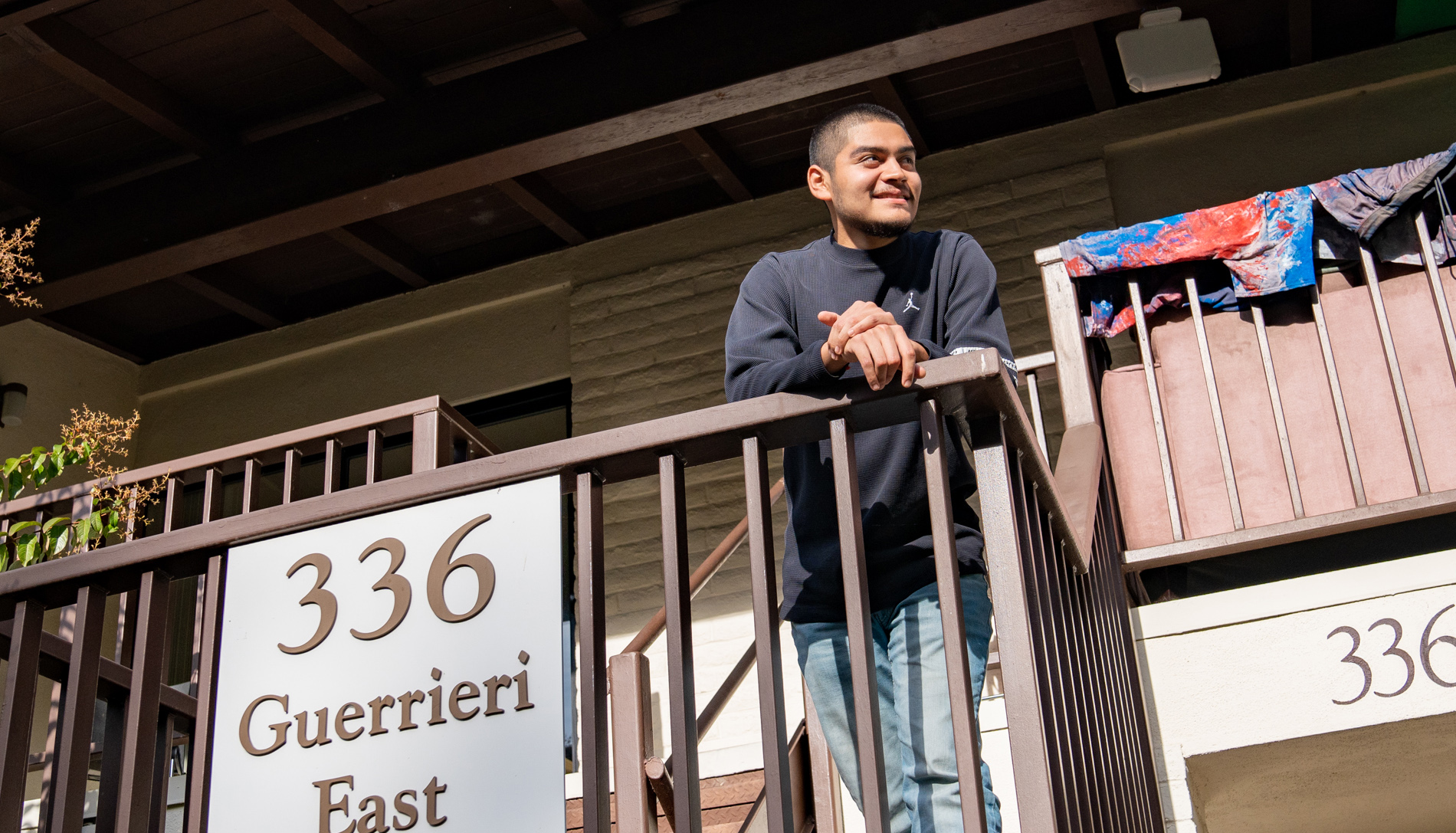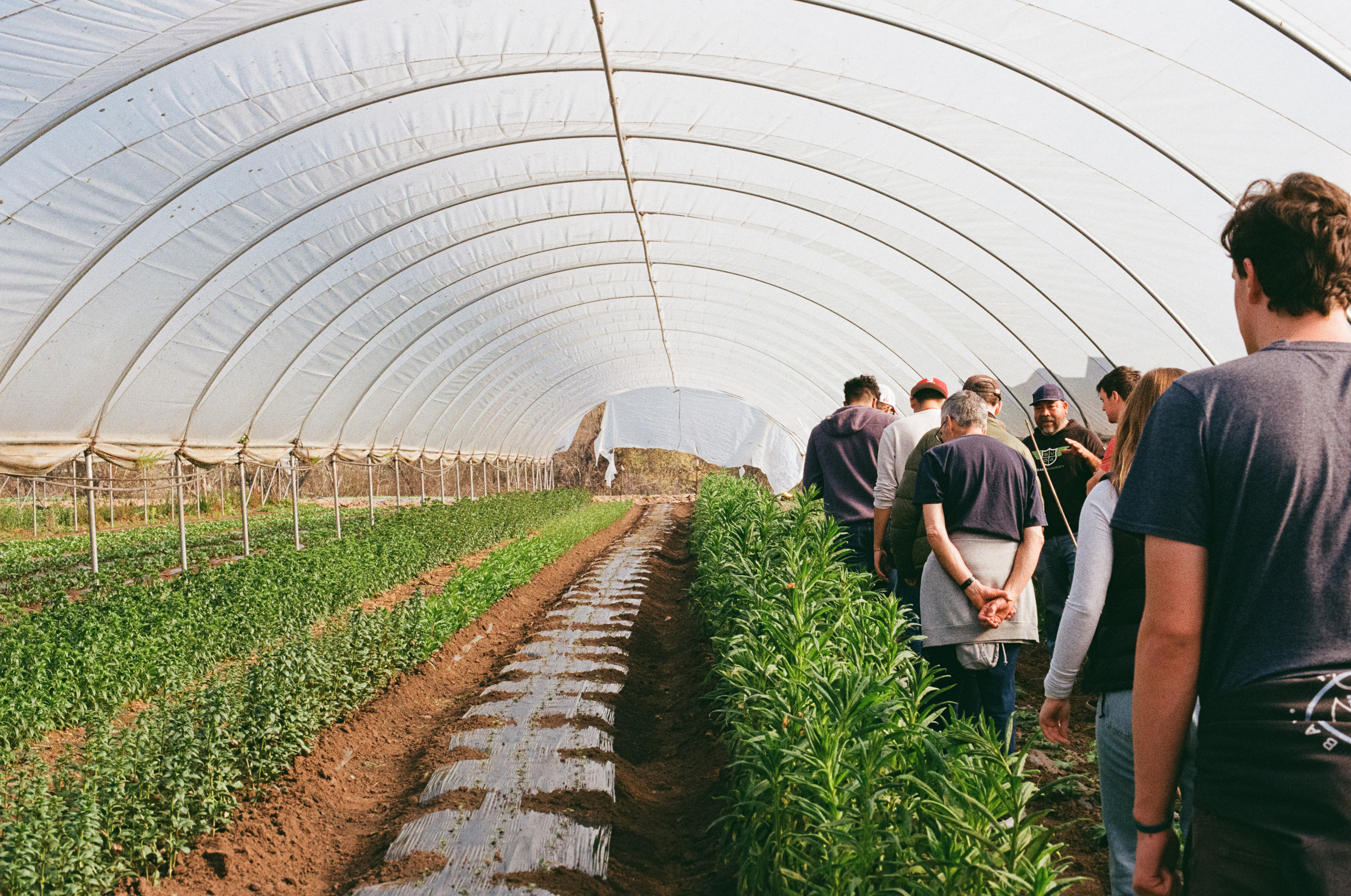
Between the rows: It's more important than ever to not only appreciate where our food comes from, but to understand how its grown. / Photo by Sam Nobile
What is the Human Cost of Food? Saint Mary’s Students Find Answers By Looking Where What We Eat is Grown
This Jan Term, the Mission and Ministry Center offered a unique opportunity to immerse students in the world of organic farming and the lives of migrant farmworkers in the Salinas Valley. Here are my takeaways.
On a Saturday in January, for the first time in my life I and a group of Saint Mary’s students went to work in the fields: stooped over and weeding strawberries on a farm in the Salinas Valley not far from Watsonville, which has earned the moniker Strawberry Capital of the World. It was careful and painstaking work, but I powered through until my lower back was in pain, my feet were sore, and I was virtually drenched with sweat—though it was a mild California winter day. I checked my phone for the time. It had been about half an hour.
Imagine doing this 12 hours a day every day of the week, I told myself, with little to no break. But beginning to understand this in a visceral way was exactly the point of this work—what it means to talk about the “human cost of food.”
Back to the Garden
Many people, including myself, are familiar with the experience of visiting their local grocery store and farmers markets to buy food on a regular basis. Browsing the various options of produce, grains, meat, and more, the choices of the consumer largely depend on two factors: what they are looking to eat within the budget they can afford. For years, I have also worked different roles in the food service industry—hustling in the kitchen and out on restaurant floors in New York, making coffee for cafe visitors in San Francisco. But January gave me the opportunity to examine some fundamental questions about the role of food in our lives.
Take food insecurity: On top of being an issue that has already been worsening over the past few years, in the face of threats like climate change, food insecurity is proving to be a critical issue for communities across this country and around the world. But especially for those of us who may not be at risk of going hungry, how often do we step back and ask about the true costs of the food on our plates in the first place? And how do we measure this other than the money we spend on it?
This January, the Mission and Ministry Center’s Justice Education team brought this big question into focus through a weekend immersion trip in the Salinas Valley. The trip, which had been suspended for five years because of the pandemic, gives students the opportunity to visit some organic farms to learn about the process of getting that food from farm to table. Inspired by the Lasallian Core Principle of Concern for the Poor and Social Justice, the trip also brought students face-to-face with some of the struggles migrant workers face in the agricultural industry.
The trip was led and organized by Brother Steven Vasoli, FSC, the Justice Education and Mission Coordinator for Mission & Ministry; Philip Goodwin ’16, the Associate Director of Alumni Engagements and Events; Karla Henriquez, the Associate Director of Financial Aid; Jen Herzog, Executive Director for Student Activities & Engagement; and Callie Buchanan ’24, MA ’26, a graduate student working as a Lasallian Scholar for Mission & Ministry, in addition to a number of other student leaders who helped organize activities throughout the weekend.
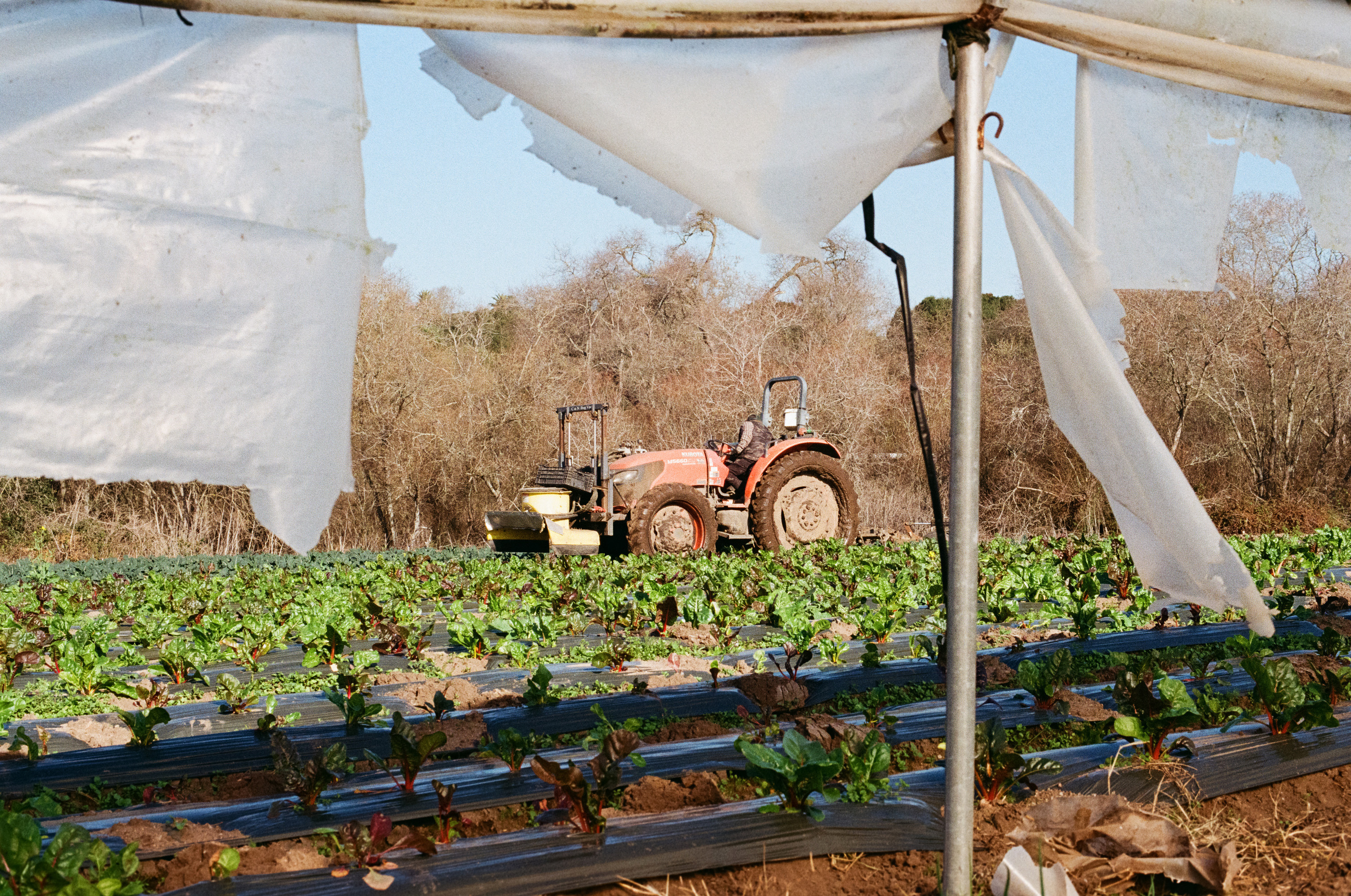
Organics and the Future of Farming
On Friday evening we headed south from Moraga to Pajaro, a working-class community just south of Watsonville, and stayed the night at San Pablo de Colores, a charismatic Catholic renewal retreat center. Saturday morning, as part of our lessons in what it means to raise crops in California, we got our hands dirty. Our first stop was JSM Organics, an organic farm based in Aromas, just west of Highway 101. Javier Zamora, who founded the farm in 2012, walked us through the details of organic farming and his goals in running the farm: raising cane berries and strawberries, vegetables and flowers. Zamora prioritizes making sure that his community has access to their food, specifically through setting fair prices depending on where it is sold. He also made it clear that important goals include educating his workers and ensuring that his farm grows high quality, healthy food.
Organic farms must follow a rigid set of guidelines that enable them to sell products that are formally certified. Zamora wanted to make sure that we understood that organic isn’t synonymous with growing crops 100% naturally. In addition to not using synthetic pesticides, being certified organic means that the farm follows the specific rules laid out for them by the nonprofit California Certified Organic Farmers (CCOF), which include the use of animal-based insecticides like PyGanic or DiPel that, while not exclusive to organic farms, help ensure organic farmers are being environmentally sensitive. (We smelled one of the barrels, which had a chocolatey, almost soy sauce-like profile.) No surprise, Zamora is an advocate for organic food as being overall better for you than its conventional counterpart. But he also cautioned against what he said was an increasing push in recent years from corporate players in organic farming to weaken organic certification guidelines. Despite this pressure, he is optimistic that young people want to educate themselves on where their food comes from, pointing to a rise in biodynamic farming as an example.
“Look at what the Earth has given us. It’s feeding us, but at the end Mother Earth will eat us, too.”
For Zamora, having JSM be an organic farm wasn’t about obtaining a special label, he says, but growing food that is genuinely delicious and healthy, and that feeds thousands of families in the area. As he toured us around his 200 acre farm—120 of which are protected under a conservation easement, with the remaining 80 acres sporting the blackberries, raspberries, blueberries, strawberries, vegetables, and flowers JSM is known for—he urged us to grow something of our own. His message: Even if it is just one plant, that in itself can be life changing. He also passed along some advice from his mother-in-law: “Look at what the Earth has given us. It’s feeding us, but at the end Mother Earth will eat us, too.”
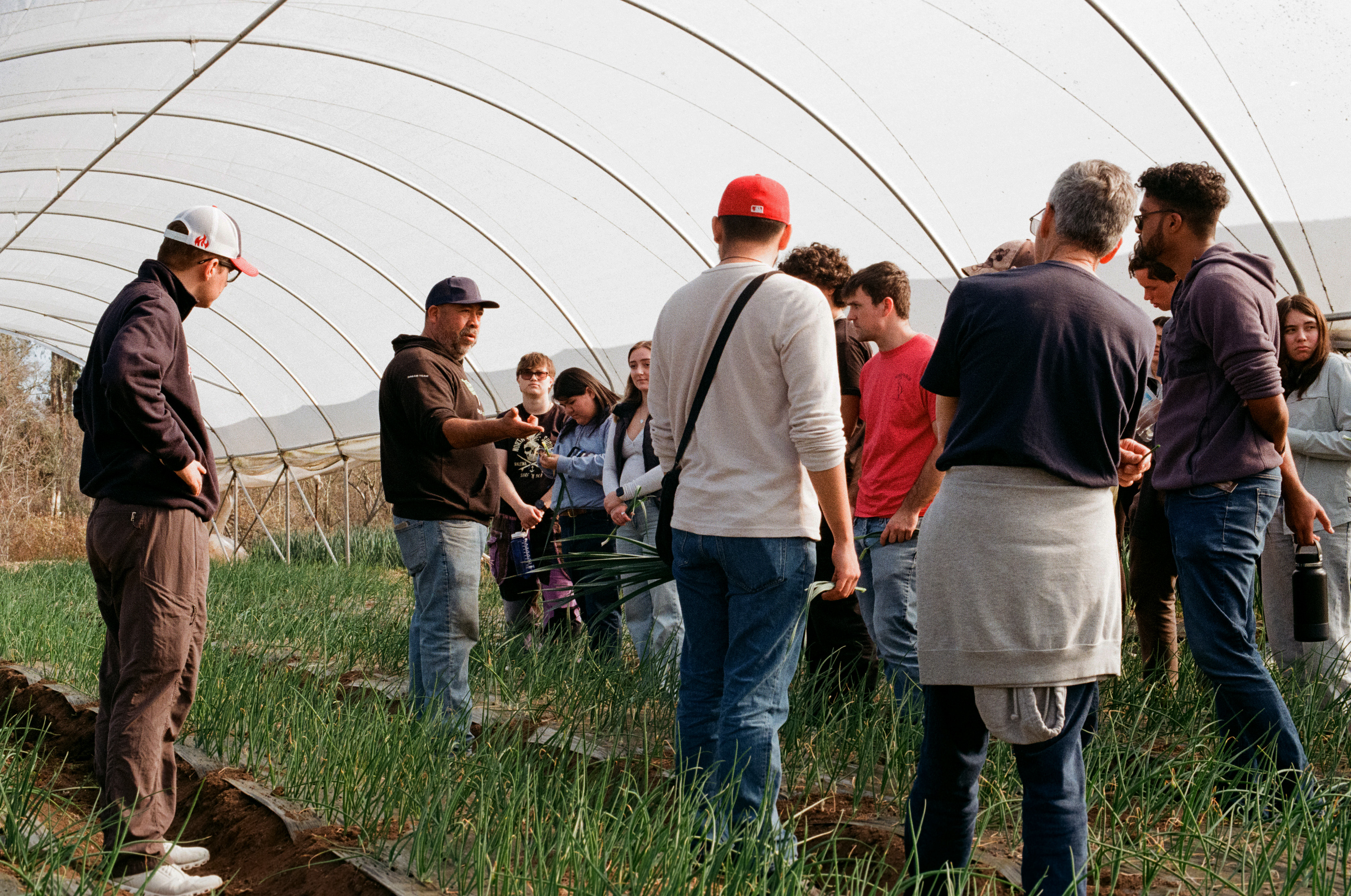
That being said, Mother Earth can also be violently unpredictable, especially in an era of tumultuous climate change. When heavy rains caused the Pajaro River to breach a levee in March 2023, it caused widespread flooding miles in length, devastating the community’s sewage system and infrastructure. With farms taking a big hit, Zamora personally lost ten acres worth of strawberries, equivalent to over $200,000. Nearly two years later, he was still fighting for his insurance policy in order to pay back the bank which had an investment in the berries.
Zamora is 60 years old. Many of the farmers he knows are 10 to 20 years older than he is. And he understands that university students are more likely to gravitate toward tech-driven careers than they are to farming. But we don’t need to grow all the food we eat to know how it’s grown; he wanted to share the knowledge he did, and he hopes that we’ll continue to educate ourselves and share it, because, as he puts it, the future of food is in our hands. So was a delicious carne asada that he prepared for us at the end of our visit.
The Effects of NAFTA on Mexican Farming Families
On Sunday we met with Dr. Ann Lopez, the founder of Center for Farmworker Families, a nonprofit organization that works to spread awareness of the often brutal conditions migrant farmworkers face, along with supporting farmworkers through a variety of donations. Lopez has spent the latter part of her career researching the devastating effects the North American Free Trade Agreement, or NAFTA, had on Mexico’s farming industry, as well as conducting and compiling numerous interviews with Mexican farmers and families. When we met with her, she explained how when NAFTA went into effect in 1994, while it largely benefited the general US population and certainly the farming industry north of the border, it also forced many Mexican farming families out of work due to a massive influx of GMO corn from the United States. As Lopez explained, these families were then given two rather grim options: Remain on their land with little to no work, or move to the US to begin farming there.
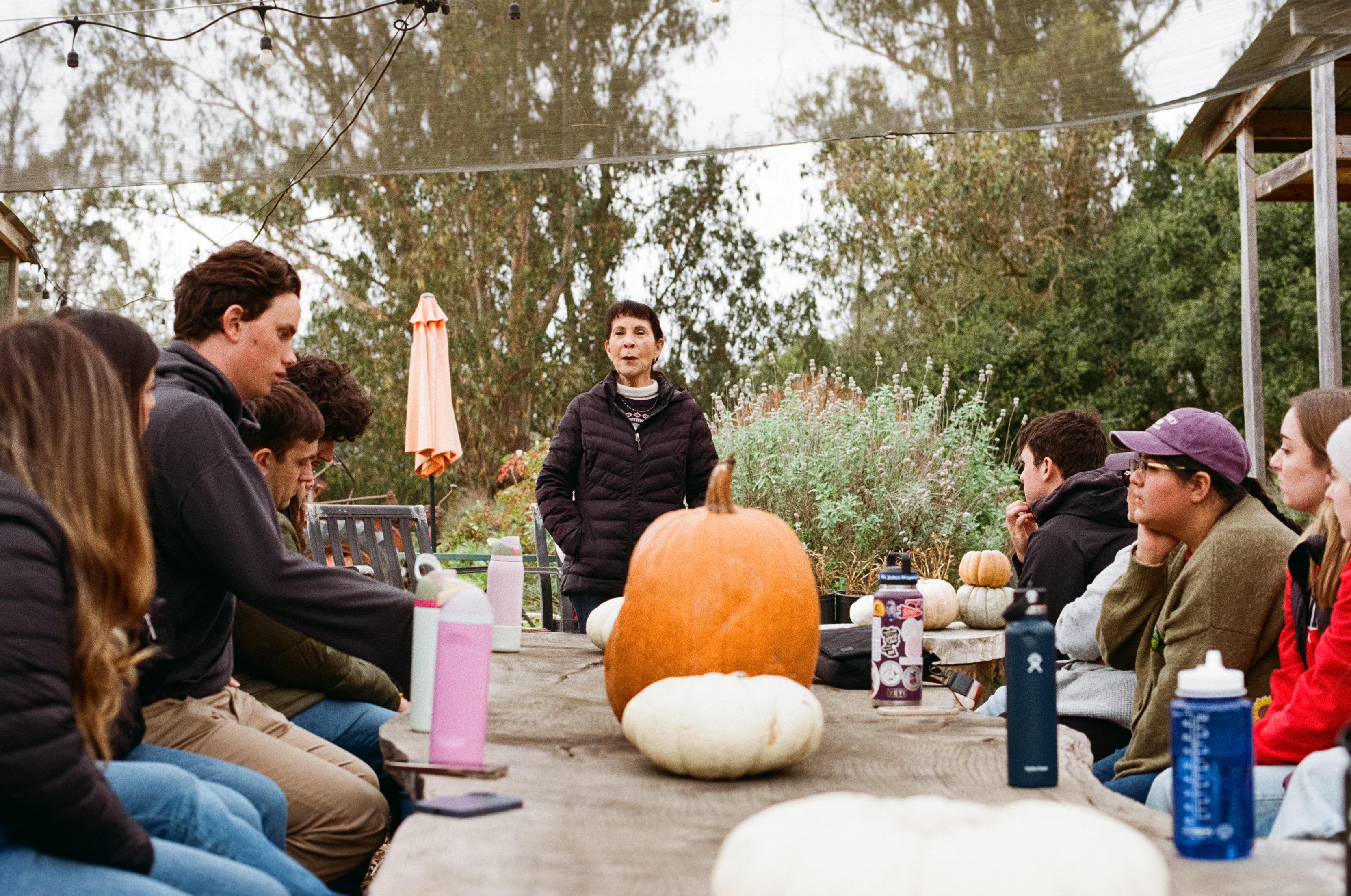
We also had the opportunity to hear from a woman I’ll call Guadalupe (not her real name), an undocumented migrant farmworker herself. She recounted her harrowing story of immigrating from Mexico to the US to look for work—and raise the food that makes it to our tables. Guadalupe and her brother left their home of Michoacán in Mexico in search of opportunity. The state was and is rife with violence from drug cartels that have also worsened economic instability. When they lived there, they could barely afford to get by, let alone enjoy any prospects of a promising future. With no other realistic option, they left home to make the trek all the way to the border, when Guadalupe was only 14 years old. As she recollected with a clear sense of distress, they faced a series of life-threatening obstacles. They met up with a coyote who told them to buy as much water and food as they could carry—that on top of the fee the coyote was already charging—before beginning the tumultuous journey through the barren, unforgiving desert that lies between Michoacán and the US border.
Out of fear of being caught by the Border Patrol, they would rest during the day, before continuing as soon as the sun set. Although they managed to avoid the relentless heat, the night presented its own problems, the main one being navigating the desert in the dark. Weakened by hunger and thirst—there was no amount of water they could have realistically brought that would be enough—they had to watch out for cactus scattered across the ground. If any of them sustained a serious injury, it couldn’t possibly be treated. When Guadalupe’s brother severely injured his ankle, he simply had to bear the pain and keep going. However, after traveling in these brutal conditions for weeks on end, the brother and sister could finally see it: The border was just within reach. That’s where the Mexican Border Patrol caught them; they escorted the siblings all the way back to Michoacán.
One thread throughout this weekend was that the people we spoke with and met with did not present themselves as victims. Strength and perseverance are what come through, despite all the obstacles they face.
Despite the risks, Guadalupe was so determined to find a better life that she chose to make the trek again. This time, though, she was alone; her brother’s ankle injury wouldn’t allow him to walk for the foreseeable future, but she couldn’t wait. After traveling with complete strangers and nothing to her name, she made it across the border. She had no money and sought work—hard to obtain, though, for undocumented 14-year-old girl. Eventually, Guadalupe finally found work on a farm in Watsonville, where she currently resides.
Her story is just one of many. And while it’s easy to be informed about the kinds of struggles migrant workers face through the internet, it’s something else entirely to hear it face-to-face. For most workers, surviving the harrowing journey to the United States does not mean an end to their worries; the fear of deportation never leaves. Yet, they push through and forge a life for themselves and their family in spite of the fear. What comes through is the incredible strength of spirit they possess. But also the fact that there is no other path to follow.
The Fear that Never Leaves
In Ernestina Solorio’s back yard, she greeted us with dozens of homemade tamales. Then she got around to introducing herself. She works with Ann Lopez to support the Center for Farmworker Families, organizing and distributing donations. Having originally immigrated to the US illegally, she was no stranger to the multitude of struggles migrant workers face. She solemnly recounted how it took her nine years and $15,000 to finally obtain a green card, living in constant fear of deportation—particularly painful, since it would mean being separated from her four children. As she told us her story, it was clear to me that, despite the fact that she was no longer in any immediate danger, that fear never left her—a point she later made explicitly.
Many migrant families rely solely on farm work as a source of income, meaning that when the seasons change and there are fewer crops to grow, there is less work to go around, leaving them unable to afford basic necessities. That’s one area where Center for Farmworker Families comes into play: In addition to spreading awareness, the center helps farmworker families get things they otherwise can’t afford. For more than four years now, Solorio has offered her backyard as the main location where people can come to get canned goods, diapers, hygiene products, clothes, and just about anything a family might need. Her generosity has helped the center establish a permanent, consistent location where families know they can come when they have nowhere else to go. Lopez and Solorio both said they welcomed donations to support the center. Increasing understanding of the challenges migrant farmworkers face is even more important, they said. One way, Lopez put it, is for our generation to take on this job: “Get out there and raise hell!”
Hope for the Future
One thread throughout this weekend was that the people we spoke with and met with did not present themselves as victims. Strength and perseverance are what come through, despite all the obstacles they face.
It is horribly ironic that the people who work to grow the food we enjoy struggle to afford it themselves. We need these workers, who toil long hours while often living in constant fear of deportation. Everyone needs to eat—so is it really so much to ask that these people can be fed, too?
On the very last night of the trip, reflecting back on the day as we had done throughout the entire weekend, the matter of privilege came up. After a lengthy, meaningful discussion, we ultimately came to the conclusion that trips like these contextualize and put into perspective the responsibilities we all inherit in being a part of an institution of higher education like Saint Mary’s. Or, as Brother Steven summarized, “The only thing those with privilege can do is give back to those who do not.”
The Mission and Ministry Center will be offering this immersion again next fall, and I for one could not recommend it enough.
Sam Nobile ’25 is studying English at Saint Mary's College and is a Student Writer at the Office of Marketing and Communications. Write him.
Story updated May 19, 2025 at 8 a.m. Pacific.



